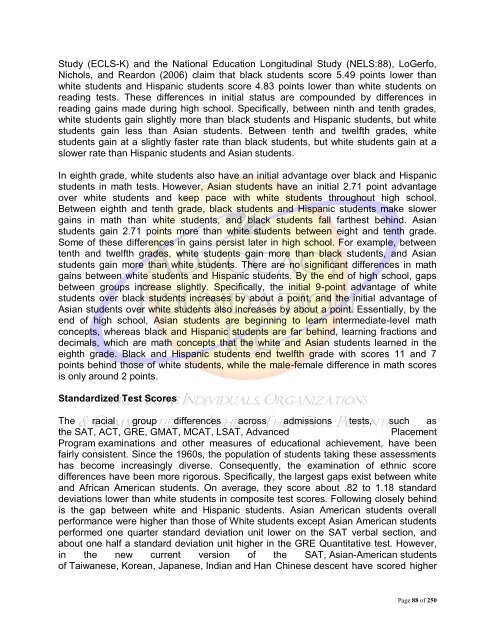Institutional Racism
Institutional Racism
Institutional Racism
Create successful ePaper yourself
Turn your PDF publications into a flip-book with our unique Google optimized e-Paper software.
Study (ECLS-K) and the National Education Longitudinal Study (NELS:88), LoGerfo,<br />
Nichols, and Reardon (2006) claim that black students score 5.49 points lower than<br />
white students and Hispanic students score 4.83 points lower than white students on<br />
reading tests. These differences in initial status are compounded by differences in<br />
reading gains made during high school. Specifically, between ninth and tenth grades,<br />
white students gain slightly more than black students and Hispanic students, but white<br />
students gain less than Asian students. Between tenth and twelfth grades, white<br />
students gain at a slightly faster rate than black students, but white students gain at a<br />
slower rate than Hispanic students and Asian students.<br />
In eighth grade, white students also have an initial advantage over black and Hispanic<br />
students in math tests. However, Asian students have an initial 2.71 point advantage<br />
over white students and keep pace with white students throughout high school.<br />
Between eighth and tenth grade, black students and Hispanic students make slower<br />
gains in math than white students, and black students fall farthest behind. Asian<br />
students gain 2.71 points more than white students between eight and tenth grade.<br />
Some of these differences in gains persist later in high school. For example, between<br />
tenth and twelfth grades, white students gain more than black students, and Asian<br />
students gain more than white students. There are no significant differences in math<br />
gains between white students and Hispanic students. By the end of high school, gaps<br />
between groups increase slightly. Specifically, the initial 9-point advantage of white<br />
students over black students increases by about a point, and the initial advantage of<br />
Asian students over white students also increases by about a point. Essentially, by the<br />
end of high school, Asian students are beginning to learn intermediate-level math<br />
concepts, whereas black and Hispanic students are far behind, learning fractions and<br />
decimals, which are math concepts that the white and Asian students learned in the<br />
eighth grade. Black and Hispanic students end twelfth grade with scores 11 and 7<br />
points behind those of white students, while the male-female difference in math scores<br />
is only around 2 points.<br />
Standardized Test Scores<br />
The racial group differences across admissions tests, such as<br />
the SAT, ACT, GRE, GMAT, MCAT, LSAT, Advanced<br />
Placement<br />
Program examinations and other measures of educational achievement, have been<br />
fairly consistent. Since the 1960s, the population of students taking these assessments<br />
has become increasingly diverse. Consequently, the examination of ethnic score<br />
differences have been more rigorous. Specifically, the largest gaps exist between white<br />
and African American students. On average, they score about .82 to 1.18 standard<br />
deviations lower than white students in composite test scores. Following closely behind<br />
is the gap between white and Hispanic students. Asian American students overall<br />
performance were higher than those of White students except Asian American students<br />
performed one quarter standard deviation unit lower on the SAT verbal section, and<br />
about one half a standard deviation unit higher in the GRE Quantitative test. However,<br />
in the new current version of the SAT, Asian-American students<br />
of Taiwanese, Korean, Japanese, Indian and Han Chinese descent have scored higher<br />
Page 88 of 250

















